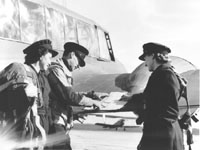


RAAF Meteorological Service
Foreword
Introduction
Chapter 1: The Weather Factor in Warfare
Chapter 2: Establishing and Developing the RAAF Directorate of Met. Services (D.Met.S)
Chapter 3: Recruiting and Training of Personnel
Senior Officers
Recruitment and Personnel
The WAAAF
Training Courses
'Who are these Met blokes?'
Chapter 4: Meteorology in Aviation
Chapter 5: The Met. Retreating
Chapter 6: The Met. Advancing
Chapter 7: The Met With the Army and the Navy
Chapter 8: Divisional Offices of the Bureau of Meteorology During the War
Chapter 9: Research and Instrumental Development
Chapter 10: The End, Aftermath, and Beyond
Appendix 1
Appendix 2
Appendix 3
Appendix 4
References
Index
Search
Help
Contact us

The WAAAF
In order to free men for meteorological service in advanced operational areas, commencing in 1941, women were recruited and trained in the Women's Australian Auxiliary Air Force (WAAAF). The first (and only) WAAAF Meteorological Officers' course was conducted in 1942, nine graduating successfully therefrom. It was difficult to obtain women with the necessary qualifications for training. The 1943 figures given in Table 2 above, include nine Meteorological Officers, 64 Meteorological Assistants, and 120 Meteorological Charters in the women's ranks. These were stationed at Divisional Offices, and at Area Meteorological Offices and RAAF bases on the mainland. They were not available for overseas service. The first WAAAF woman officer was Section Officer Elizabeth Burke, who was employed in the forecasting section headquarters. She was joined in 1943 by Flight Officers Kathleen Atherton, Agnes Carnegie and Doris Scott.
Kath Atherton, MBE, now living in Queensland, was a Section Officer forecaster in the D.Met.S. She wrote me a long letter which probably typifies very well the lifestyle of the WAAAF, and because of that, it is worth quoting almost verbatim. She recalls her training as a Met. officer as 'one of the busiest and hardest working times of my whole life'. Kath, with other trainees, 'lived in a big room, an old billiard room with large open fireplaces, at St. Kilda Road, Melbourne'. It was the 'WAAAFERY'. Here they 'studied' at night, then travelled by trams, and walked each day to the 'old Bureau'. Kath continued:
'Our first lectures were held in that dilapidated old building across the street—the old Trades Hall, I believe. We worked hard, but were a very happy group. Straphanging in trams, we would be learning off our weather codes, or studying the advertising signs. We murmured our codes 'sotto voce'. One day I heard Nessie (another WAAAF colleague) murmuring '09—fog in the distance, but not at the station', again and again, until I became aware of a slight change '09—Laxettes, the gentle and efficient laxette for children' (an advertisement on the tram). In spite of this, Nessie's marks in tests far surpassed those of the rest of us. It must have been about July 1943 that I was posted to Townsville as Assistant Area Meteorological Officer to Squadron-Leader Arthur White, staying at St. Anne's Barracks. I travelled each day out to Sidney Street, where, dug into the north-western side of Castle Hill, was the concealed Operation Room and Area Meteorological Office. There were a number of assistants and charters at Sidney Street, working on signals and passing them on. Squadron-Leader White was one of the most knowledgeable people about weather that I was privileged to meet. He took everything in a relaxed and calm manner, smoking interminable cigars!'[19]
Organisations in Australian Science at Work - Directorate of Meteorological Services (D.Met.S)
People in Bright Sparcs - White, Arthur Charles
 |
Bureau of Meteorology |  |
© Online Edition Australian Science and Technology Heritage Centre and Bureau of Meteorology 2001
Published by Australian Science and Technology Heritage Centre, using the Web Academic Resource Publisher
http://www.austehc.unimelb.edu.au/fam/0236.html